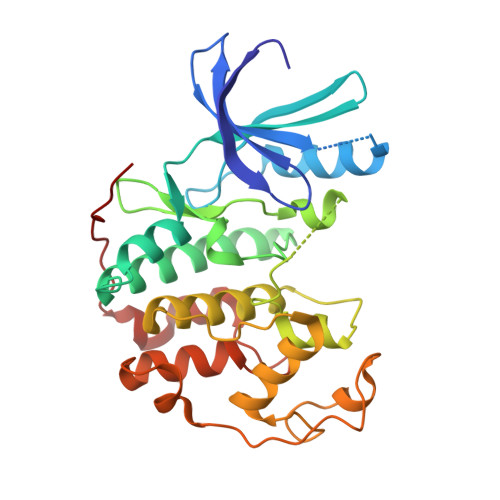Crystallographic approach to identification of cyclin-dependent kinase 4 (CDK4)-specific inhibitors by using CDK4 mimic CDK2 protein.
Ikuta, M., Kamata, K., Fukasawa, K., Honma, T., Machida, T., Hirai, H., Suzuki-Takahashi, I., Hayama, T., Nishimura, S.(2001) J Biol Chem 276: 27548-27554
- PubMed: 11335721
- DOI: https://doi.org/10.1074/jbc.M102060200
- Primary Citation of Related Structures:
1GIH, 1GII, 1GIJ - PubMed Abstract:
Genetic alteration of one or more components of the p16(INK4A)-CDK4,6/cyclin D-retinoblastoma pathway is found in more than half of all human cancers. Therefore, CDK4 is an attractive target for the development of a novel anticancer agent. However, it is difficult to make CDK4-specific inhibitors that do not possess activity for other kinases, especially CDK2, because the CDK family has high structural homology. The three-dimensional structure of CDK2, particularly that bound with the inhibitor, has provided useful information for the synthesis of CDK2-specific inhibitors. The same approach used to make CDK4-specific inhibitors was hindered by the failure to obtain a crystal structure of CDK4. To overcome this problem, we synthesized a CDK4 mimic CDK2 protein in which the ATP binding pocket of CDK2 was replaced with that of CDK4. This CDK4 mimic CDK2 was crystallized both in the free and inhibitor-bound form. The structural information thus obtained was found to be useful for synthesis of a CDK4-specific inhibitor that does not have substantial CDK2 activity. Namely, the data suggest that CDK4 has additional space that will accommodate a large substituent such as the CDK4 selective inhibitor. Inhibitors designed to bind into this large cavity should be selective for CDK4 without having substantial CDK2 activity. This design principle was confirmed in the x-ray crystal structure of the CDK4 mimic CDK2 with a new CDK4 selective inhibitor bound.
Organizational Affiliation:
Banyu Tsukuba Research Institute/ Merck Research Laboratories, Okubo 3, Tsukuba, Ibaraki 300-2611, Japan.















